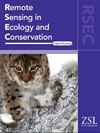Thermal drone observations capture fine‐scale population decline of short‐tailed shearwaters
IF 4.3
2区 环境科学与生态学
Q1 ECOLOGY
引用次数: 0
Abstract
Monitoring seabird populations is increasingly urgent as numerous species become more vulnerable to climate change and urbanisation. Surveying burrow‐nesting seabirds is challenging due to their nocturnal behaviour, the inaccessibility of colonies, and the disturbance that monitoring poses to nesting sites. Traditional survey methods, which are manual transects conducted by researchers (~200 m), extrapolate this data to derive the population estimates of entire colonies. To enhance the accuracy beyond interpolated data, a survey method was developed using Unoccupied Aerial Systems (UAS) equipped with thermal sensors to survey short‐tailed shearwaters (热无人机观测捕获了短尾鹱的小尺度种群下降
随着许多海鸟物种越来越容易受到气候变化和城市化的影响,监测海鸟的数量变得越来越紧迫。由于海鸟在夜间活动,难以接近巢穴,以及监测对筑巢地点造成的干扰,对洞穴筑巢海鸟进行调查具有挑战性。传统的调查方法是由研究人员进行人工样条(约2亿),推断这些数据来得出整个殖民地的人口估计。为了提高插值数据的精度,开发了一种使用配备热传感器的无人机系统(UAS)来测量短尾鹱(Ardenna tenuirostris)的测量方法。从2019年到2024年收集了繁殖群体的热图像,提供了全面的覆盖,捕获了每个群体中所有被占用的洞穴(小鸡存在)。在此期间,被占用的洞穴密度从每平方米0.28个下降到0.18个。雏鸡数量从2019年的6129只下降到2024年的4445只,下降了27%。洞穴占用率随样带位置的不同而变化很大(0%-66%),这突出了使用安装在无人机上的热传感器提供完整空间数据的优势。这表明计数并不一致,突出了使用样条数据估计雏鸡产量的偏差。在热图像上施加了一系列模拟样带,以比较整个群体的小鸡计数与外推计数。根据这项研究的数据,我们估计目前全球短尾鹱的繁殖种群为1350万只,比1985年全球估计的2300万只减少了约41%。这项研究强调了新兴技术的实用性,它解决了研究夜间活动或在偏远/难以到达的栖息地的物种的挑战。
本文章由计算机程序翻译,如有差异,请以英文原文为准。
求助全文
约1分钟内获得全文
求助全文
来源期刊

Remote Sensing in Ecology and Conservation
Earth and Planetary Sciences-Computers in Earth Sciences
CiteScore
9.80
自引率
5.50%
发文量
69
审稿时长
18 weeks
期刊介绍:
emote Sensing in Ecology and Conservation provides a forum for rapid, peer-reviewed publication of novel, multidisciplinary research at the interface between remote sensing science and ecology and conservation. The journal prioritizes findings that advance the scientific basis of ecology and conservation, promoting the development of remote-sensing based methods relevant to the management of land use and biological systems at all levels, from populations and species to ecosystems and biomes. The journal defines remote sensing in its broadest sense, including data acquisition by hand-held and fixed ground-based sensors, such as camera traps and acoustic recorders, and sensors on airplanes and satellites. The intended journal’s audience includes ecologists, conservation scientists, policy makers, managers of terrestrial and aquatic systems, remote sensing scientists, and students.
Remote Sensing in Ecology and Conservation is a fully open access journal from Wiley and the Zoological Society of London. Remote sensing has enormous potential as to provide information on the state of, and pressures on, biological diversity and ecosystem services, at multiple spatial and temporal scales. This new publication provides a forum for multidisciplinary research in remote sensing science, ecological research and conservation science.
 求助内容:
求助内容: 应助结果提醒方式:
应助结果提醒方式:


